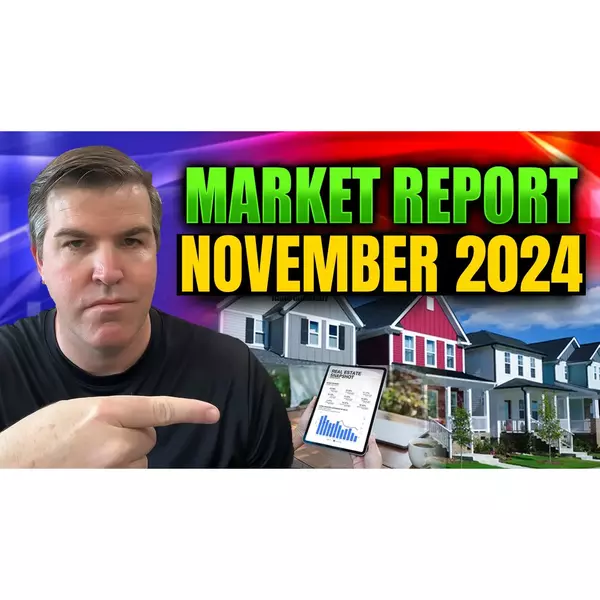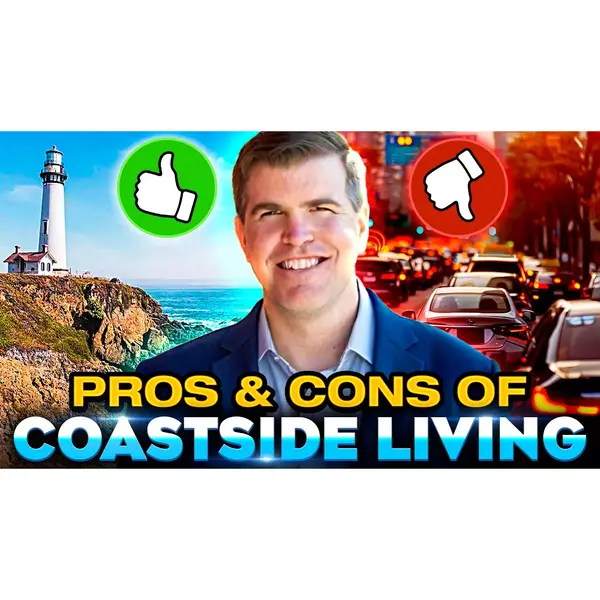

Bay Area Housing Market Update - November 2024
Bay Area Housing Market Update - November 2024 Hi everyone, this is Sean Engmann with your housing market report for November. The elections are in the rearview mirror and though most people have been focusing on the presidential election, there were a number of key state and local changes that are likely to have more of an impact on the housing market than the presidential campaign. Two key ballot measures went down to defeat. Prop 5 would have lowered the threshold for approval of bonds for housing and infrastructure, which means that the threshold for affordable housing bonds remains at two-thirds. Prop 33, which would have enabled local governments to expand rent control, also went down to a resounding defeat. Both of these measures had the potential to substantially impact the housing market, but things will continue as-is. Prop 36, which increases penalties for theft and drug crimes, overwhelmingly passed. That has the potential to help property values through the reduction of crime and it also could help stem the exodus from the Bay Area since the beginning of the pandemic, where every Bay Area county has seen a reduction in population. Thinking of selling your home? Download The Power Seller's Guide for expert strategies and proven tips to help you navigate the selling process with confidence. San Francisco will have a new mayor in January and expanding and streamlining new housing were key elements of his platform. These proposals include reducing fees and inclusionary requirements for housing projects, revising zoning to help create new housing projects, and opposing the expansion of rent control which Mayor Breed had supported. One of the immediate reactions to the election was that the Fed reduced interest rates by 25 basis points, which was the second rate cut this year. The last cut did not translate into any relief in the mortgage rates. Rates had been slowly trending down from 7.5% in April to 6.15% at the time of the rate cut. Since then, rates climbed back over 7% and sit just below that mark as of November 8th. The high rate environment hasn’t tremendously hurt the housing market, though things are moving at a slower pace than they were when rates were at record lows. Median house sales through the first three quarters came in at just under $2M in San Mateo County, followed by Santa Clara County at $1.9M, Marin at $1.725M, San Francisco at $1.639M, and Alameda at $1.31M. It’s notable that San Francisco, which used to lead the way, has slipped to the fourth most expensive county. In San Mateo, the market continues to move briskly as 59% of homes sold above their list price, that’s down from the Spring but right in line with the seasonal trend. Things should continue to proceed as normal through the winter months with inventory drying up and the market slowing down for the holidays. Of course, there will be some areas that are more active than others. Most forecasters are expecting a boost in inventory and a reduction in interest rates as we enter 2025. I’m a little more cautious as the inflation numbers continue to rise and the employment numbers remain relatively weak. As such, I don’t anticipate a substantial reduction in mortgage rates, though they may continue to very slowly work their way down. For sellers, now is a great time to begin getting your home ready for the Spring market which will be here before we know it, and if trends hold, will be very competitive throughout the Bay Area. For buyers, winter is always a good time to get a deal as many other buyers are on the sidelines for the holidays. Your pickings might be a bit slimmer though. If you're considering selling or know someone who is, check out my Power Seller's Guide, which is chock full of tips and useful information about the process. It is a great resource for anyone thinking of selling or who wants to learn more about the selling process. Want to stay updated with the latest real estate tips, market insights, and more? Subscribe to my YouTube channel for exclusive content! Subscribe to My YouTube Channel
Read More

Pros & Cons: Living on the Half Moon Bay Coastside
The San Mateo county Coastside is a part of the Bay Area that has been largely undiscovered by many people locally. Today, I’m going to tell you about the pros and cons of living on the Coastside. I’m Sean Engmann a Realtor with eXp Realty based on the Coastside in Half Moon Bay. As I am a transplant to the Coast having been born and raised in San Francisco, I have the unique perspective of seeing it both as a local and as a transplant. The Coastside of San Mateo county, as opposed to the more popular and much more populated Bayside, consists primarily of Half Moon Bay to Pacifica but extends south beyond Pescadero. Half Moon Bay is perhaps best known for its Pumpkin Festival every October and Pacifica for its Fog Fest each September. The area is also host to the world renowned Maverick’s surfing competition every year and is home to several well-known restaurants, including Sam’s Chowder House and the Moss Beach Distillery. The first pro and con about living on the Coastside is its isolation, particularly in the areas south of Pacifica. Only three roads connect the south of the coastside to the rest of the county – Highway 1, Highway 92 and Highway 84. Surrounded by mountains and an ocean, the area is physically isolated, and that isolation gets exacerbated by any road closures. Major accidents at Devil’s Slide that shut Highway 1 in both directions tend to occur every couple of months, and both Highways 92 and 84 are prone to shutdown during bad weather. On the best of days, it’s a 20-25 minute drive to reach the rest of San Mateo county or San Francisco, which is a deterrent for some, and traffic in and out of the area can be difficult on weekends and holidays especially. The pro about the isolation is that there is a sense of community on the Coastside that really can’t be found anywhere else in the Bay Area. The towns are small, so people in the area tend to know each other very well. Coastside Gives is an annual charity event that really brings people on the Coastside together. There’s a shared experience here that is unique and draws many people to the community on the Coast. The area is also very supportive of its local schools and businesses. A second pro is that the outdoor activity is unmatched anywhere else in San Mateo county. There’s a reason why so many people drive here to go to the beaches – they are spectacular. There are hiking trails abound and lots to do if you love the outdoors, especially if you love to surf. If you’re looking for great nightlife, you’ll need to go over the hill or into the City. Most places close up shop early, and while places like Old Princeton Landing do have some great live music, you’re not going to be able to find much to do on the Coast after 10, and getting back here after a night out somewhere else can be challenging. The lack of walkability or accessibility via public transit on the Coastside can be an issue to many people coming from more urban areas. The Coastside is relatively spread out and has very minimal bus service, so if you want to go somewhere, chances are you need to drive to do so. On the weekends, driving from town to town can be a bit challenging due to traffic – at least until you learn some local shortcuts. While the nightlife may not be there, there is plenty to do during the day, even if you’re not up for the outdoors life. Main Street in Half Moon Bay features great shopping from local merchants, and there is no shortage of quality restaurants in the area, especially downtown and in the harbor area. Ketch Joanne, Barbara’s Fish Trap, Mezzaluna and the Half Moon Bay brewing company are all excellent choices in the harbor. There are also several pop-up markets, like the second Saturdays market in the harbor featuring great food and local merchandise. The weather is another pro or con depending on how you look at it. While the Coast is known for its fog, the fog isn’t really that prevalent everywhere, especially back in the valley. Coastal temperatures are cooler and more temperate than places further inland, especially during the summer. Air conditioning is not needed here on the Coast, except maybe a couple days a year. The schools in the Half Moon Bay area are run by the Cabrillo Unified School district while in Pacifica the schools are run by the Jefferson Union School district out of Daly City. The schools are closely aligned with and well supported by the community. For those seeking private options, Pacific Bay in Pacifica is the closest option for high school in the area and there are other smaller private schools at the grammar school level. The best other options are in the City and over the hill. In terms of affordability, the Coastside is one of the most affordable areas in which to live when looking at the median price points of homes. It is isolated, but a short drive to the rest of the county, San Francisco and Silicon Valley, and it boasts a strong sense of local pride and community. In terms of scenic and natural beauty, living on the Coast is majestic and you are surrounded by natural beauty. If you’d like more information about living on the Coastside, please feel free to leave a comment below. If you are considering buying or selling here on the Coast, I’d love to help you, just give me a call at: 650-238-9210.
Read More

Buying and Selling at the Same Time
Buying and Selling at the Same Time For today’s real estate tip we’re discussing buying and selling a home at the same time, which can be especially challenging if you need a mortgage on your new home and also need funds from the sale of your current home for a down payment. Having the ability to pay cash for your new home or to cover the down payment on the new home are huge advantages, but this video is designed for those who don’t have those advantages. Buying and selling at the same time is not only a significant financial undertaking but also an emotionally taxing process. The enormity of the financial concerns, combined with the uncertainty about your living situation, especially in the short term, can be overwhelming. It can feel like you have no control, but it’s important to remember that many people have successfully pulled off this move, and there are multiple ways to do so. The process requires careful planning, and one of the first steps is sitting down as a family to discuss what’s important and to work through potential problems together. Preparing for the move and the sale will be disruptive and stressful, but if everyone knows what to expect, it reduces the stress caused by uncertainty or surprise. Thinking about selling your home? Download The Power Seller's Guide for expert strategies and tips to navigate the process confidently. The first step in managing this process is hiring a listing agent. This agent can also represent you in the purchase of your new home or recommend someone who can. The Realtor's knowledge of the market will be invaluable in helping you craft a strategy. The second step is finding a lender and getting preapproved for a mortgage on the purchase. Your lender can also discuss financing options like bridge loans, which can help facilitate the transition. During this process, it’s important to avoid taking on lots of credit card debt or making large purchases, as this could affect your mortgage approval. Another important step is finding a moving company, particularly one that also offers storage services. Once you’ve identified these professionals, the next steps involve preparing your home for sale—decluttering, removing personal items, and making minor upgrades while you’re still living in the home. Your Realtor can provide a specific plan tailored to your situation. Deciding whether to buy first or sell first is a complex one, and your goals will play a significant role in this decision. Buying first gives you the luxury of choosing your property and might allow you to avoid moving twice, but it’s often more costly and involves more risk.It’s more costly because, unless you can pay cash for the new home or have the cash for a down payment, you’ll need either a bridge loan or a similar program—these can be expensive, especially if it takes a while to sell your home. The risks include not knowing exactly what your current home will sell for, which could put you in a difficult financial situation if it sells for less than expected. Also, if your home takes a long time to sell, or worse, doesn’t sell, it can be a crippling financial hit. However, buying first also allows you to have your current home vacant while it’s on the market, potentially enabling you to get a higher price. On the other hand, selling first removes these uncertainties but can put pressure on you to find a new home quickly, potentially leading you to compromise on some of the things that made you want to move in the first place. There’s also the challenge of your living situation after you’ve sold your home. Since you haven’t bought your new place yet, you need a plan—whether that’s staying with friends or relatives, getting a short-term rental, or staying in a hotel. Negotiating a rent-back is an option to avoid two moves and may make sense if your home is in a seller’s market, but that can add a layer of complexity, especially if there’s a hiccup in escrow on the buy side. This approach involves two moves and can be incredibly stressful. Another option is a hybrid approach, where you list your home while living there and house hunt at the same time. This approach can be helpful in a time crunch, and if everything goes right, it could allow you to coordinate closings. However, it doesn’t totally mitigate the challenges from either of the other approaches and can, in fact, exacerbate them. I’ve mentioned rent-back agreements, but using contingencies can also be an option depending on the dynamics of the market. In a seller’s market, purchasing a home contingent upon the sale of your current home is a very difficult contingency to secure, though it may be easier if you’re selling to get a contingency on finding a new home, depending on the flexibility of the buyers. However, this will likely cost you money on the purchase price. If you decide to buy first, it’s critical to have a good estimate of what your home will sell for and how quickly it will sell. This information will guide your purchase price and help you estimate the carrying costs of maintaining two mortgages. Having items in storage already and preplanning the move will help streamline the process. Investigating different financing options, such as bridge loans or other programs, is also key to ensuring you can manage the transition smoothly. If you’re selling first, having a detailed plan for preparing and selling the home while you’re still living there is crucial to minimizing disruptions. Your Realtor can guide you through the process of decluttering, making necessary upgrades, and staging the home to present it in the best possible light. However, if getting top dollar is your most important goal, moving out of the home into temporary accommodations before putting it on the market is probably the best approach. This allows you to present your home in its absolute best light, maximizing the sale price. Defining your overall goals and crafting a plan to meet them is critical. This process starts with hiring a Realtor who is a great process manager and problem solver. If you’re moving into your forever home, I strongly recommend doing everything possible to buy first so that you have no regrets about your home, unless time is not a factor. If time is not a factor, selling first is the best option, especially if you’re relocating or think you might be making a move in the not-too-distant future. Regardless of your approach, pricing your home properly is critical, and I would not recommend pricing above the market. If a quick sale is a priority, a below-market pricing strategy may be the best fit. For more information about buying and selling at the same time and for some strategies, don't forget to check out my Power Seller's Guide. It has a wealth of information about different approaches to buying and selling at the same time as well as tips and insight to help at every stage in the selling process. Want to stay updated with the latest real estate tips, market insights, and more? Subscribe to my YouTube channel for exclusive content! Subscribe to My YouTube Channel
Read More
Recent Posts











